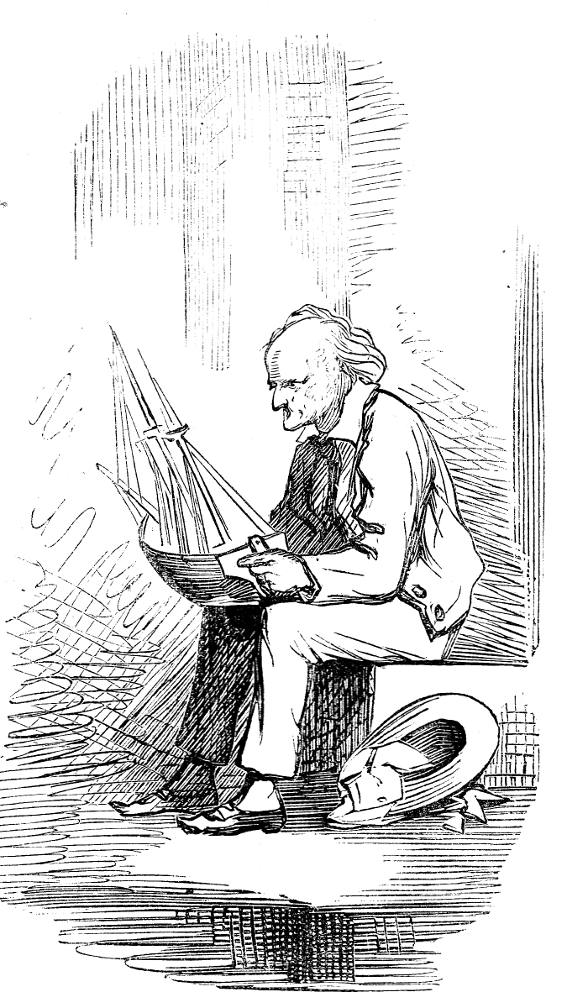

“Noel Vanstone, Esq., did you say!” asked the Postmaster. Wood-engraving 11.4 cm high by 11.7 cm wide, or 4 ½ inches square, framed, for instalment thirty in the American serialisation of Wilkie Collins’s No Name in Harper’s Weekly [Vol. VI. — No. 301] Number 30, “The Fourth Scene — Aldborough, Suffolk.” Chapter XI (page 638; p. 186 in volume), plus an uncaptioned vignettte of a “weather-beaten old man-servant” with a model boat (Chapter XII) (p. 638; p. 187 in volume): 9.5 cm high by 5.6 cm wide, or 4 inches high by 2 ¼ inches wide, vignetted. [Instalment No. 30 ends in the American serialisation on page 639, at the end of Chapter XII. Precisely the same number containing Chapters XI and XII without any illustration ran on 4 October 1862 in All the Year Round.]
Main Illustration: Wragge’s Finessing of the Postmaster at Aldborough
“Suppose a letter has been wrongly directed by mistake?” he began. “And suppose the writer wants to correct the error after the letter is put into the box?”
“When a letter is once posted, sir,” reiterated the impenetrable local authority, “nobody out of the office touches it on any pretense whatever.”
“Granted, with all my heart,” persisted the captain. “I don’t want to touch it — I only want to explain myself. A lady has posted a letter here, addressed to ‘Noel Vanstone, Esq., Admiral Bartram’s, St. Crux-in-the-Marsh, Essex.’ She wrote in a great hurry, and she is not quite certain whether she added the name of the post-town, ‘Ossory.’ It is of the last importance that the delivery of the letter should not be delayed. What is to hinder your facilitating the post-office work, and obliging a lady, by adding the name of the post-town (if it happens to be left out), with your own hand? I put it to you as a zealous officer, what possible objection can there be to granting my request?”
The postmaster was compelled to acknowledge that there could be no objection, provided nothing but a necessary line was added to the address, provided nobody touched the letter but himself, and provided the precious time of the post-office was not suffered to run to waste. As there happened to be nothing particular to do at that moment, he would readily oblige the lady at Mr. Bygrave’s request.
Captain Wragge watched the postmaster’s hands, as they sorted the letters in the box, with breathless eagerness. Was the letter there? Would the hands of the zealous public servant suddenly stop? Yes! They stopped, and picked out a letter from the rest.
“‘Noel Vanstone, Esquire,’ did you say?” asked the postmaster, keeping the letter in his own hand.
“‘Noel Vanstone, Esquire,’” replied the captain, “‘Admiral Bartram’s, St. Crux-in-the-Marsh.’”
“Ossory, Essex,” chimed in the postmaster, throwing the letter back into the box. “The lady has made no mistake, sir. The address is quite right.”
Nothing but a timely consideration of the heavy debt he owed to appearances prevented Captain Wragge from throwing his tall white hat up in the air as soon as he found the street once more. All further doubt was now at an end. Mrs. Lecount had written to her master — therefore, Mrs. Lecount was on her way to Zurich! [“The Fourth Scene — Aldborough, Suffolk.” Chapter XI: in the American serialisation, p. 638; p. 185 in volume]
Vignette Illustration: Wragge Stops at St. Crux to Bring Noel Vanstone to London
“Which door shall I drive to, sir?” asked the coachman. “The front or the back?”
“The back,” said Captain Wragge, feeling that the less notice he attracted in his present position, the safer that position might be.
The carriage twice crossed the stream before the coachman made his way through the grounds into a dreary inclosure of stone. At an open door on the inhabited side of the place sat a weather-beaten old man, busily at work on a half-finished model of a ship. He rose and came to the carriage door, lifting up his spectacles on his forehead, and looking disconcerted at the appearance of a stranger.
“Is Mr. Noel Vanstone staying here?” asked Captain Wragge.
“Yes, sir,” replied the old man. “Mr. Noel came yesterday.”
“Take that card to Mr. Vanstone, if you please,” said the captain, “and say I am waiting here to see him.” [“The Fourth Scene — Aldborough, Suffolk.” Chapter XII: in the American serialisation, p. 639; p. 187 in volume]
Commentary: Captain Wragge's Decisiveness and Strategizing Prove Indispensable
Both illustrations point to Captain Wragge’s active strategizing to get the intrusive Mrs. Lecount out of the way so that he can stage-manage the marriage of “Susan Bygrave,” the alias for Magdalen Vanstone, to the housekeeper’s malleable employer. He shrewdly manipulates the local postmaster, a punctilious civil servant, into revealing that Mrs. Lecount has taken the forged letter routed through Zurich, Switzerland, as genuine, and is accordingly on her way to her brother’s bedside. He does not need to actually read her response; he merely needs to know that it has been posted. Then, with little time to spare, he collects Noel Vanstone as previously arranged, and takes him to the scene of his marriage.
Image scans and text by Philip V. Allingham. [You may use these images without prior permission for any scholarly or educational purpose as long as you (1) credit the person who scanned them and (2) link your document to this URL in a web document or cite the Victorian Web in a print one.]
Bibliography
Blain, Virginia. “Introduction” and “Explanatory Notes” to Wilkie Collins's No Name. Oxford World's Classics. Oxford: Oxford University Press, 1986.